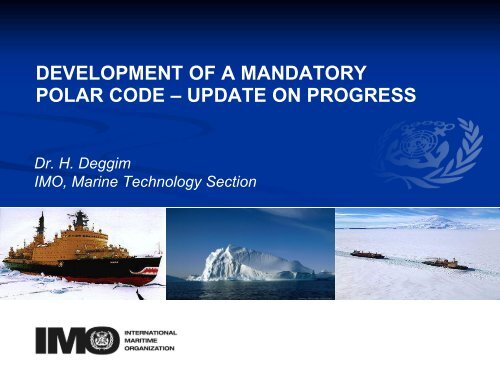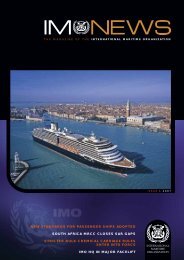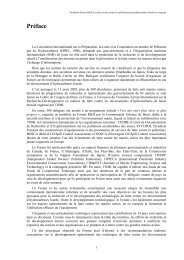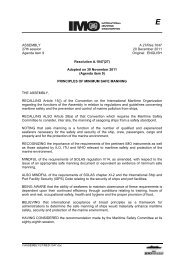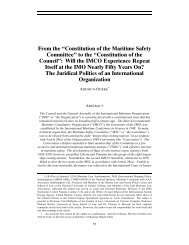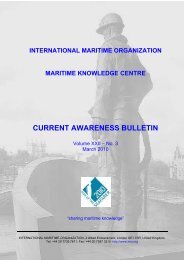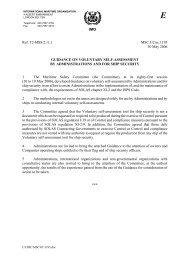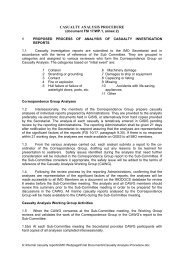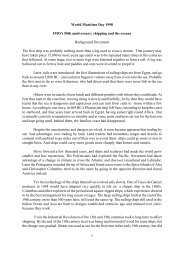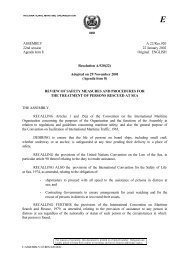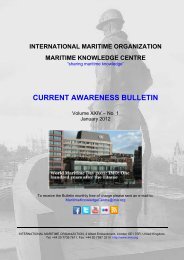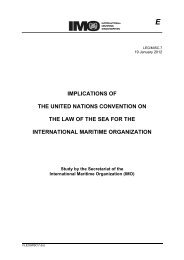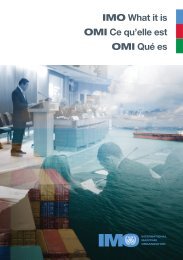Development of a Mandatory POLAR Code - IMO
Development of a Mandatory POLAR Code - IMO
Development of a Mandatory POLAR Code - IMO
Create successful ePaper yourself
Turn your PDF publications into a flip-book with our unique Google optimized e-Paper software.
DEVELOPMENT OF A MANDATORY<br />
<strong>POLAR</strong> CODE – UPDATE ON PROGRESS<br />
Dr. H. Deggim<br />
<strong>IMO</strong>, Marine Technology Section<br />
YOUR LOGO
Presentation topics<br />
<strong>IMO</strong> and ships operating in polar waters<br />
• Existing regulatory framework for ice-covered areas<br />
- United Nations Convention on the Law <strong>of</strong> the Sea<br />
(UNCLOS)<br />
- SOLAS, MARPOL and STCW requirements<br />
- Related guidelines and recommendations<br />
- Fishing vessels<br />
• Current activities in <strong>IMO</strong> with regard to polar areas,<br />
specifically the ongoing development <strong>of</strong> a mandatory<br />
International <strong>Code</strong> <strong>of</strong> Safety for Ships Operating in Polar<br />
Waters<br />
Page 2 • 2<br />
YOUR LOGO
The regulatory framework<br />
Requirements affecting ships operating in polar regions<br />
Safety requirements apply<br />
to all ships which are<br />
subject to the Convention<br />
operating in Polar regions.<br />
Provides the mandatory<br />
level environmental<br />
protection with zero<br />
discharge requirements<br />
for Antarctica.<br />
Legal framework<br />
governing the rights and<br />
responsibilities <strong>of</strong> nations<br />
in their use <strong>of</strong> ocean<br />
space.<br />
Newly adopted guidance<br />
and recommendations<br />
for training and<br />
competency <strong>of</strong> <strong>of</strong>ficers<br />
and masters on ships in<br />
polar regions.<br />
Page 3 • 3<br />
YOUR LOGO
UNCLOS<br />
United Nations Convention on the Law <strong>of</strong> the Sea (UNCLOS)<br />
• Legal framework governing the rights and<br />
responsibilities <strong>of</strong> nations in their use <strong>of</strong> ocean space<br />
• Entered into force in 1994, to date signed by 162<br />
countries<br />
• Article 234: “Coastal States have the right to adopt<br />
and enforce non-discriminatory laws and regulations<br />
for the prevention, reduction and control <strong>of</strong> marine<br />
pollution from vessels in ice-covered areas within the<br />
limits <strong>of</strong> the exclusive economic zone ...”<br />
Page 4 • 4<br />
YOUR LOGO
SOLAS requirements<br />
Chapter V navigational requirements<br />
Regulation V/5<br />
Meteorological services and warnings<br />
• collection examination, dissemination and exchange <strong>of</strong> meteorological data by<br />
ships at sea, including ice data<br />
Regulation V/6<br />
Ice Patrol Service<br />
• requires ships transiting the region <strong>of</strong> icebergs guarded by the Ice Patrol during<br />
the ice season to make use <strong>of</strong> the services provided by the Ice Patrol<br />
Regulations V/31 and V/32<br />
Danger messages<br />
• obliging masters to communicate information on dangers to navigation, including<br />
dangerous ice, and specifications<br />
Page 5 • 5<br />
YOUR LOGO
Ship stability<br />
2008 Intact Stability <strong>Code</strong><br />
• mandatory (Part A) and recommendatory (Part B)<br />
provisions concerning intact stability <strong>of</strong> all types <strong>of</strong><br />
ships covered by <strong>IMO</strong> instruments<br />
• Part B, chapter 6 (Icing considerations) contains<br />
provisions for ships operating in areas where ice<br />
accretion is likely to occur which would adversely<br />
affect a ship’s stability and provides that icing<br />
allowances should be included in the analysis <strong>of</strong><br />
conditions <strong>of</strong> loading<br />
Page 6 • 6<br />
YOUR LOGO
Guidelines for ships in polar waters<br />
Recommendations for ships operating in polar waters<br />
• 2002 - MSC/Circ.506 –<br />
Guidelines for ships<br />
operating in Arctic icecovered<br />
waters<br />
• 2004 - ATCM request to<br />
extend to Antarctic<br />
• 2007 – MV Explorer sinking<br />
• 2009 – A.1024(26) –<br />
Guidelines for ships<br />
operating in polar waters<br />
Page 7 • 7<br />
YOUR LOGO
A.1024(26)<br />
Guidelines for ships operating in polar waters<br />
• Adopted by 26 th <strong>IMO</strong> Assembly in 2009<br />
• Main features:<br />
- Requirements for ship construction, equipment, operation<br />
and environmental protection<br />
- Application extended to all polar waters, i.e. Arctic and<br />
Antarctic, and not only ice-covered<br />
- Only partially or totally enclosed lifeboats allowed<br />
- Qualifications <strong>of</strong> ice navigators<br />
- High standards for environmental protection<br />
- New damage stability provisions in line with revised<br />
SOLAS chapter II-1<br />
Page 8 • 8<br />
YOUR LOGO
Cold water survival<br />
The Pocket Guide<br />
• MSC.1/Circ.1185 – Guide to<br />
cold water survival<br />
• Advice on how to prevent or<br />
minimize hazards <strong>of</strong> cold<br />
exposure, including self-help<br />
techniques<br />
• Useful checklists for cold<br />
water survival and for<br />
rescuers<br />
9<br />
YOUR LOGO
Remoteness from SAR facilities<br />
<strong>IMO</strong> Guidance for ships operating in remote areas<br />
• Guidance for passenger ships operating in areas<br />
remote from SAR facilities (MSC.1/Circ.1184)<br />
Enhanced planning arrangements for ships operating in<br />
remote areas, including close cooperation and liaison with<br />
relevant RCCs.<br />
• Guidelines on voyage planning for passenger ships<br />
operating in remote areas (A.999(25))<br />
Recommends additions to yoyage and passage plan, such<br />
as details on ice and ice formations, ice navigators,<br />
operational limitations due to ice, safe distance to icebergs,<br />
carriage <strong>of</strong> special or enhanced equipment.<br />
Page 10 • 10<br />
YOUR LOGO
Polar classes<br />
International standards to support SOLAS requirements<br />
PC1<br />
PC2<br />
PC3<br />
PC4<br />
PC5<br />
PC6<br />
PC7<br />
Page 11 • 11<br />
<strong>POLAR</strong> CLASS DESCRIPTION<br />
Year-round operation in all ice-covered<br />
waters<br />
Year-round operation in moderate multiyear<br />
ice conditions<br />
Year-round operation in second-year ice<br />
which may include multi-year ice<br />
inclusions<br />
Year-round operation in thick first-year ice<br />
which may include old ice inclusions<br />
Year-round operation in medium first-year<br />
ice which may include old ice inclusions<br />
Summer/autumn operation in medium firstyear<br />
ice which may include old ice<br />
inclusions<br />
Summer/autumn operation in thin first-year<br />
ice which may include old ice inclusions<br />
<strong>IMO</strong> Polar Guidelines<br />
• Only ships with Polar Class<br />
designation, based on IACS<br />
Unified Requirements for Polar<br />
Class Ships, should operate in<br />
polar waters<br />
• Or comparable alternative<br />
standard <strong>of</strong> ice-strengthening<br />
• Ice description follows WMO<br />
sea ice nomenclature<br />
(see box opposite)<br />
YOUR LOGO
MARPOL requirements<br />
Antarctic – zero discharge protection<br />
MARPOL Annex I<br />
Control <strong>of</strong> discharge <strong>of</strong> oil and reception facilities<br />
• Prohibits any discharge into the sea <strong>of</strong> oil or oily mixtures from any ship in the<br />
Antarctic area; requires adequate reception facilities<br />
MARPOL Annex II<br />
Control <strong>of</strong> discharge <strong>of</strong> residues <strong>of</strong> noxious liquid substances<br />
• Prohibits any discharge into the sea <strong>of</strong> noxious liquid substances or mixtures<br />
containing such substances in the Antarctic area<br />
MARPOL Annex V<br />
Disposal <strong>of</strong> garbage<br />
• Prohibits the disposal into the sea <strong>of</strong> all plastics and all other garbage; requires<br />
reception facilities, with special rules for the Antarctic area<br />
Page 12 • 12<br />
YOUR LOGO
Other MARPOL requirements<br />
Prevention <strong>of</strong> oil pollution in polar regions<br />
• Use and carriage <strong>of</strong> heavy grade oil<br />
New chapter 9 <strong>of</strong> MARPOL Annex I, establishing a<br />
ban on the use and carriage <strong>of</strong> heavy grade oils in<br />
the Antarctic area, entered into force on 1 August<br />
2011.<br />
• Oil spill response in ice and snow conditions<br />
The OPRC-HNS Technical Group operating under<br />
the MEPC is preparing guidance on oil spill<br />
response in ice and snow conditions.<br />
Page 13 • 13<br />
YOUR LOGO
STCW requirements<br />
Training and competency <strong>of</strong> seafarers<br />
• Training guidance for personnel on ships<br />
operating in ice-covered waters<br />
Newly adopted guidance stresses importance for<br />
<strong>of</strong>ficers in charge <strong>of</strong> a navigational/engineering<br />
watch on board ships operating in polar waters to<br />
have sufficient and appropriate experience with<br />
polar waters.<br />
• Measures to ensure the competency <strong>of</strong> masters<br />
and <strong>of</strong>ficers <strong>of</strong> ships operating in polar waters<br />
Recommends that Governments adopt measures to<br />
ensure that masters and <strong>of</strong>ficers <strong>of</strong> ships operating<br />
in polar waters have appropriate training and<br />
experience.<br />
Page 14 • 14<br />
YOUR LOGO
Fishing vessels<br />
Ice accretion<br />
Torremolinos Protocol<br />
Regulation III/8 – Ice accretion<br />
• Icing allowances for stability calculations, ship design to minimize ice accretion,<br />
means for removing ice<br />
<strong>Code</strong> <strong>of</strong> safety for fishermen and fishing vessels<br />
Part A, appendix 10, and Part B, section 3.8<br />
• Reduction <strong>of</strong> formation <strong>of</strong> ice and icing allowances for stability calculations for<br />
fishing vessels <strong>of</strong> 24 m and over in length<br />
Voluntary guidelines for small fishing vessels<br />
Design, construction and equipment<br />
• Provisions regarding ice accretion and combating <strong>of</strong> ice formation for fishing<br />
vessels between 12 m and 24 m in length<br />
Page 15 • 15<br />
YOUR LOGO
<strong>Mandatory</strong> Polar <strong>Code</strong><br />
New <strong>IMO</strong> instrument under development<br />
• MSC 86 in 2009 approved proposals for development<br />
<strong>of</strong> mandatory Polar <strong>Code</strong> and instructed DE S-C<br />
• Recognition that different measures for Arctic and<br />
Antarctic may be appropriate<br />
• DE 53 in 2010 started work on the development<br />
• Basic structure <strong>of</strong> draft <strong>Code</strong> <strong>of</strong> safety for ships<br />
operating in polar waters under development by<br />
Correspondence Group for further work by DE 55 in<br />
February 2012<br />
Page 16 • 16<br />
YOUR LOGO
<strong>Mandatory</strong> Polar <strong>Code</strong><br />
Issues under consideration<br />
• Goal-based: objectives and functional requirements<br />
• Hazard identification, risk analysis and risk control options<br />
• Application to ship types/sizes (SOLAS, non-SOLAS)<br />
• <strong>Mandatory</strong> and recommendatory provisions<br />
• Operational limitations based on geographical boundaries<br />
• Risks posed by shipping to Arctic indigenous and other<br />
local communities<br />
• Add-on <strong>Code</strong> versus stand-alone instrument<br />
Page 17 • 17<br />
YOUR LOGO
<strong>Mandatory</strong> Polar <strong>Code</strong><br />
Contents <strong>of</strong> the draft <strong>Code</strong><br />
• Certification<br />
• Design<br />
• Equipment and systems<br />
• Operation<br />
• Environmental protection<br />
• Manning and training (to some extent)<br />
Page 18 • 18<br />
YOUR LOGO
<strong>Mandatory</strong> Polar <strong>Code</strong><br />
Categories <strong>of</strong> ships operating in polar waters<br />
A<br />
B<br />
C<br />
• Operating in waters with 10%<br />
or more ice<br />
• Polar class or equivalent<br />
• Operating in waters with less<br />
than 10% ice, but which may<br />
pose a structural risk<br />
• Assessment/ice-strengthening<br />
• Operating in waters with 0 to<br />
10% ice, but which does not<br />
pose a structural risk<br />
• No ice-strengthening<br />
Page • 19<br />
YOUR LOGO
<strong>Mandatory</strong> Polar <strong>Code</strong><br />
Challenges<br />
• Geographical limitations – new discussion<br />
• Additional risks/additional requirements<br />
• Mitigation <strong>of</strong> additional risks<br />
• Extent <strong>of</strong> additional environmental protection measures<br />
• Fishing vessels/ passenger non-SOLAS ships<br />
• Ship categories A, B and C – especially the C category<br />
• Sailing permit system in addition to ice certification<br />
• Time – progress<br />
Page 20 • 20<br />
YOUR LOGO
<strong>Mandatory</strong> Polar <strong>Code</strong><br />
Current geographical boundaries Arctic/Antarctic (as set<br />
out in Polar Guidelines) under consideration<br />
Page 21 • 21<br />
YOUR LOGO
<strong>Mandatory</strong> Polar <strong>Code</strong><br />
Polar Workshop, Cambridge, 27 to 30 Sep 2011<br />
• Environmental aspects <strong>of</strong> Polar <strong>Code</strong><br />
• Hazard identification workshop<br />
• <strong>IMO</strong> Member States + observers<br />
• Objective: identify all potential hazards and<br />
their causes for navigation in polar waters<br />
• Routine releases into environment<br />
(combustion gases, bilge water, ballast<br />
water, lubricants, waste, etc.)<br />
• Accidental releases into environment<br />
(cargo, containers, bunker fuel oil)<br />
• Report to DE 55 in Feb 2012<br />
Page 22 • 22<br />
YOUR LOGO
Thank you for listening.<br />
www.imo.org<br />
Page 23 • 23<br />
YOUR LOGO


